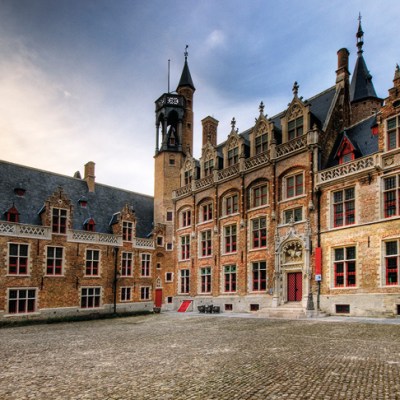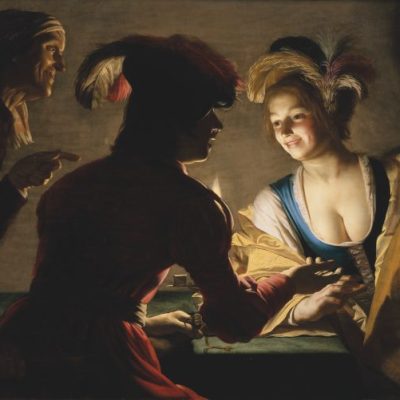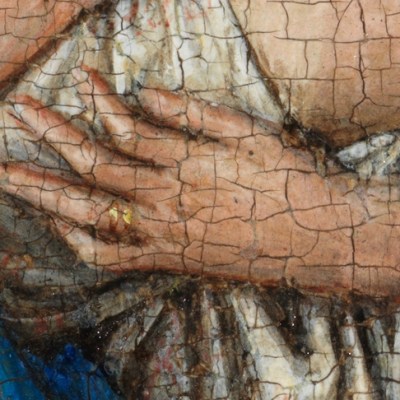It would be unusual to come to Burgundy and not, at some point, talk about wine. But I hadn’t expected it to seep into my conversation with the director of the Musée des Beaux-Arts in Dijon, the region’s capital. Up on a top floor of this sprawling museum, once the palace of the extravagantly wealthy dukes of Burgundy, David Liot is urging me not to look at the gallery around us (filled, I later discover, with the animal sculptures of Rodin’s one-time assistant, François Pompon), but out of the window: across the Cour de Bar, named for a rival duke imprisoned in the tower here, to the roof of the old palace kitchens. He traces the route by which platters of food and jugs of wine would be taken from this service area, with its six vast fireplaces, to the banqueting hall and its minstrels’ gallery. ‘At the end of the 14th century,’ he says, ‘Dijon was the European centre for the arts, yes – but also for gastronomy and viticulture.’
The palace is a UNESCO World Heritage Site, not in its own right, but, with the city, as part of Burgundy’s climats: 1,247 vineyard parcels on the ‘golden slope’ south of Dijon, each differentiated by the wine it produces. The historic centre of Dijon is included in the listing for embodying ‘the political regulatory impetus that gave birth to the climats system’. It was Philip the Bold, the first of the Valois dukes of Burgundy, who seems to have been responsible for this. In 1395 he issued an edict banning the more easily cultivated red Gamay vine, which he called a ‘wicked and disloyal variety’, in favour of pinot noir, since when the grape has been all but synonymous with red Burgundy. ‘That,’ Liot says, ‘was the origin of the grand cru.’ Some also credit Philip the Bold with the popularisation of Dijon’s eponymous mustard. In what sounds like an apocryphal story, his motto moult me tarde (‘I am impatient’) was elided to moult tarde, and stamped on pots of the condiment made in the region (whence moutarde).
The legacy of Philip the Bold and his successors is more solidly present in the museum’s architecture and collection. ‘You can’t understand this museum,’ Liot insists, ‘if you don’t understand the architecture and the heritage, and the relationship with the city.’ This is something he himself has learned over the last few years. Previously director of the Musée des Beaux-Arts in Reims (‘a city with a very different identity, because it was destroyed by the First World War – I had to think a lot about the 20th century’), he arrived in Dijon in 2015 to oversee the second stage of the museum’s €60m renovation, completed in May this year. By that time new stores had already been built just out of town, to house whatever of the collection of more than 130,000 pieces is not on display at any one time. They also provided new conservation areas (another €5m was found to conserve works of art returning to display, or being displayed for the first time).
Along with the Louvre, Dijon’s Musée des Beaux-Arts, which opened in 1799, is one of the oldest public museums in France. And like its venerable big sister in Paris, this 18th-century museum occupies a former medieval palace. (While Philip the Bold was remodelling his ducal residence in Dijon, his brother Charles V, king of France, was doing the same at the Louvre.) The challenge for the architects, then, was to rationalise and unify six centuries of the building’s development, incorporating the distinct periods within that. They have succeeded elegantly, and any necessary 21st-century additions have been done with great sensitivity: a new structure made to house a set of lifts, prominently visible in the Cour de Bar, has been given a golden roof in a nod to the region’s signature polychrome glazed tiles. It’s a subtle, but aptly noble effect, blending beautifully with the palace’s sandy Burgundy stone. More practically, this decade-long project has increased the museum’s space by 50 per cent – mainly by moving a library and administrative offices elsewhere – yielding two new galleries for temporary exhibitions, and making the count 50 rooms altogether for the permanent collection. This is set out in more or less chronological order, and runs from ancient Egypt, Greece and Rome to contemporary art. While more broadly it encapsulates the history of European art over that long span of time, within that narrative lies the history of the region’s artistic development. Artists from or working in Dijon are represented in most galleries. A whole room is dedicated to the artist couple François and Sophie Rude, the latter a pupil of Jacques-Louis David. The former’s plaster model for the Marseillaise relief on the Arc de Triomphe takes pride of place, Sophie’s face having provided the model for the shrieking genius. Nearby is her painting of 1841, The Duchess of Burgundy Halted at the Gates of Bruges, all sumptuous silks amid mobbish chaos. A room next door displays a group of strikingly modern-looking realist portraits by the young painter Félix Trutat, and Courbet-inspired work by Alphonse Legros, who left Dijon for Paris and then London, where he was professor of fine art at the Slade from 1876–92.
Portrait of the Artist and his Mother (c. 1846), Félix Trutat. Photo: © Musée des Beaux-Arts de Dijon/François Jay

Many of these artists had attended the École de Dessin set up by painter and sculptor François Devosge – himself a student of François Rude – in 1766. The idea for a museum developed from the school pre-1789, while the Revolution itself ‘freed’ a glut of art and objects from private or religious ownership. When the museum opened to the public it had in its collection 287 paintings and 240 sculptures. Among them, the Fontainebleau-school Lady at her Toilette from the late 16th century was seized in 1792 from a prominent Dijon collector; Jean Tassel’s wonderfully severe portrait from around 1648 of widow-turned-mother superior Catherine de Montholon was taken from the city’s convent of the Ursulines. The artworks the Louvre sent to Dijon in the early 19th century under the Chaptal decree provided more highlights. Jan Brueghel the Elder’s Le Château de Mariemont (1612), Rubens’ Virgin Presenting the Infant Christ to St Francis of Assisi (1618), and Guido Reni’s Adam and Eve date from this round of Napoleonic-era deposits, as does Veronese’s Finding of Moses (c. 1580), previously in the collection of Louis XIV at Versailles.
But it was the École de Dessin that supplied the museum’s very first permanent holdings. In 1775, Dijon established its own Prix de Rome, each year sending pupils from the drawing school – one painter, one sculptor – to the Eternal City for four years. In return, the students would send work home to furnish the school, including, in their final year, copies of Old Masters or classical sculptures. It was to display these Italian copies and other works from the Dijon school that an east wing was added to the ducal palace (which by this time also incorporated the Hôtel de Ville) in the 1780s. The neoclassical Salle des Statues dates from this addition, its boiserie done by the sculptor Jérôme Marlet, and still adorned with some of the student copies of ancient sculptures: the Borghese Gladiator, the Apollo Belvedere and the Venus de’ Medici are all here in their contrapposto glory. High over their heads, the ceiling is decorated with a large canvas by Pierre Paul Prud’hon, who won Dijon’s Prix de Rome in 1784, and while there was commissioned by the States of Burgundy – apparently not short of ambition – to paint a copy of Pietro da Cortona’s baroque ceiling, The Triumph of Divine Providence (1633–39), in the Palazzo Barberini. While Prud’hon disliked Cortona’s fresco, calling it a ‘noisy machine’, he nevertheless obliged with a decorative canvas loosely based on the original scheme, translating the papal symbols of Urban VIII into insignia and allegories appropriate to the prince of Condé, governor of Burgundy. The painting was removed and worked on for more than a year during the museum’s recent renovation.
The Salles des Statues at the Musée des Beaux-Arts de Dijon. In the centre is Hebe and the Eagle of Jupiter (1847–55) by François Rude. Photo: © Musée des Beaux-Arts de Dijon
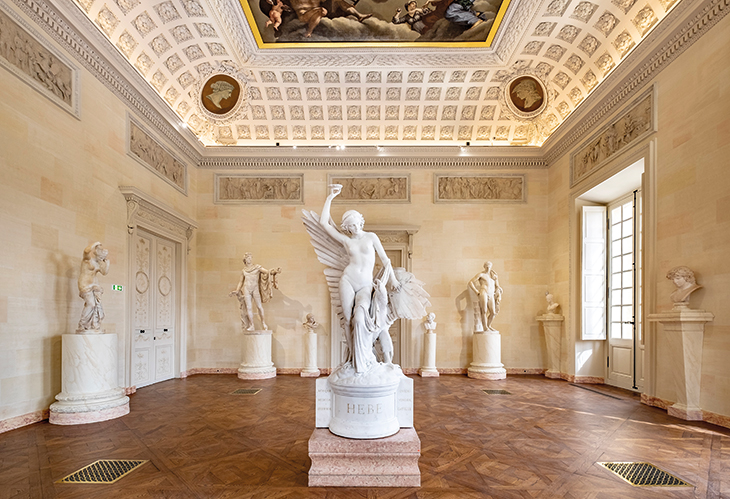
Liot and his curatorial team are keen to honour this particular identity. ‘Because of their Prix de Rome,’ he says, ‘the evolution of the museum is very closely connected to the evolution of the school. Because of the schools, you have always had a real relationship between living artists and the museum, which is quite rare in the history of museums.’ For that reason, the first temporary exhibition post-renovation is a show of work by the Chinese painter Yan Pei-Ming, who studied at Dijon’s École National Supérieure d’Art in the 1980s (ENSA, heir to the original art school), and has lived in the city ever since. An oil by Pei-Ming from 2013 is also currently the most recent work in the museum’s permanent collection.
Reflecting that close connection, the role of director of the École de Dessin and that of the museum were traditionally one and the same. It was the portraitist Charles Févret de Saint-Mémin, director from 1817 until his death in 1852, who secured for the museum perhaps its most significant exhibits: the monumental tomb of Philip the Bold and of John the Fearless with Margaret of Bavaria, made for the monastery of Champmol – at the time just outside Dijon. Founded by Philip the Bold in 1385, the Carthusian charterhouse was intended as a dynastic mausoleum for his new Valois-Burgundy duchy. With funds acquired from his marriage to Margaret of Flanders (which had extended the Burgundian territories into the Low Countries), Philip and his successors commissioned some of the finest Flemish and French artists and craftsmen to enrich the monastery.
Altarpiece of the Crucifixion (1390–99), Jacques de Baerze and Melchior Broederlam. Photo: © Musée des Beaux-Arts de Dijon/François Jay
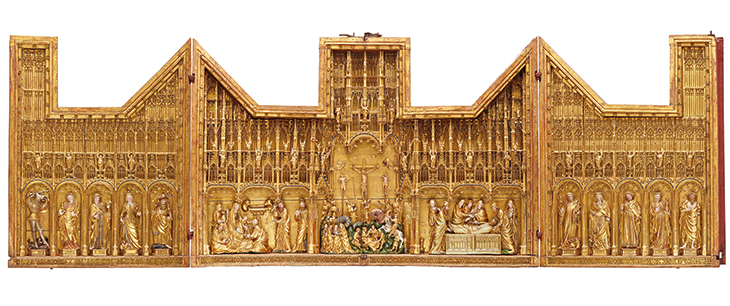
As a (particularly rich) kind of appetiser to the ducal tombs – housed in the former banqueting hall, now known as the Salle des Gardes – some of the results of the Champmol commissions now line the long Galerie de Bellegarde, built in the early 17th century to connect the ‘New Tower’ of Philip the Bold with the ducal residence of Philip the Good. Portraits of the four successive Burgundy dukes hang at the gallery’s entrance, including that of Philip the Good from the studio of Rogier van der Weyden (after a lost original). The main event here, however, is a magnificent pair of Flemish altarpieces commissioned by Philip the Bold in 1390. Jacques de Baerze, a sculptor based in Dendermonde, carved wood relief scenes from the Crucifixion and of the Saints and the Martyrs, set within a gothic architectural framework almost lacelike in its delicacy. The panels were then sent to Melchior Broederlam in Ypres, official painter of the count of Flanders (father-in-law to Philip the Bold), to be gilded. The scenes from the Life of Christ on the doors of the larger Crucifixion retable are his only surviving paintings.
Annunciation and Visitation (wing from the altarpiece of the Crucifixion; 1390–9), Melchior Broederlam. Photo: © Musée des Beaux-Arts de Dijon/François Jay
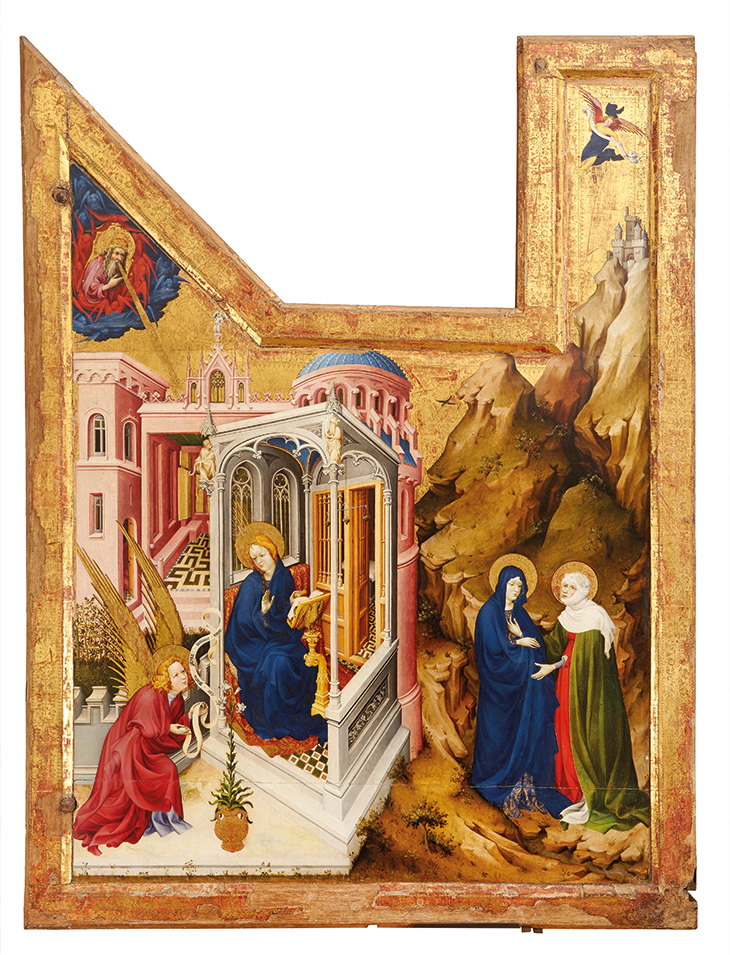
Double doors at the end of this gallery open into the grand Salle des Gardes, where the ducal tombs have rested for the best part of two centuries – since the charterhouse was dissolved during the Revolution and its contents dispersed. With the stucco figures of the deceased on the two tombs lying well above eye level, the focus of these monuments is the parade of alabaster mourners under the marble dais: monks, clergy, choirboys, and members of the duke’s entourage – all wearing the hooded cloaks that were handed out at funerals. Such pleurant figures were not new in medieval art – their strikingly expressive and realistic treatment here was: carved in the round rather than in relief, they stand in different poses of grief through a framework of cloisters, perhaps representing those at Champmol, recalling the end point of the duke’s lavish, months-long funeral procession from Halle to Dijon. Claus Suter was the Netherlandish sculptor responsible for these sorrowful figures on Philip’s tomb, and his style was immediately emulated, not least in the double tomb commissioned by Philip the Good a few decades later, for his parents John the Fearless and Margaret of Bavaria.
The emulation continues next door in a room off the Salle des Gardes, where nine 19th-century reproductions of individual mourners are ranged along a display ledge. They were sculpted in 1820–27 by an alumnus of Dijon’s art school, Jean-Baptiste-Louis-Joseph Moreau, to stand in for originals that disappeared from the tombs after the Revolution (many would reappear over the years in museums and private collections: the Louvre returned one, the Cluny two; four are in the collection of the Cleveland Museum of Art). Moreau added a playful touch to his neo-gothic replicas, carving a few of them with recognisable faces, his own and the museum director’s among them. Above this identity parade hangs Auguste Mathieu’s painting of the Salle des Gardes in 1847, the gothic arches and tracery around the tombs’ pleurants answered in the monumental fireplace at the far end. Mathieu has the room’s inside wall hung with highlights of the museum’s collection, packed tight together: Rubens and Reni are here, as is Jean-François Colson’s beautifully languid 18th-century genre scene Rest.
The Salle des Gardes at the Museum of Dijon in 1847 (1847), Auguste Mathieu. Photo: © Musée des Beaux-Arts de Dijon/François Jay

Elsewhere now, these paintings are kept company by what Moreau’s canvas couldn’t have included – significant works that entered the museum after 1847, mostly through a series of large bequests. One of the most arresting sections of the medieval galleries contains 15th-century work by Swiss and Rhenish artists, rare for having survived the Reformation. Altarpiece panels painted by Konrad Witz and names such as the Master of the Carnation of Baden were a gift from the Dijon collector Marie-Henriette Dard in 1916, as was an extraordinary wooden sculpture of the apostle St John asleep, attributed to the Basel-based Martin Hoffmann, c. 1515. The Renaissance rooms, meanwhile, are well served by treasures collected by Anthelme and Edma Trimolet, Lyonnais painters who left a large bequest to the Dijon museum in 1878, which includes Limoges enamels and an equally jewel-like early Lotto portrait.
Boy Blowing on Firebrand (c. 1660), Georges de la Tour. Photo: © Musée des Beaux-Arts de Dijon/Hugo Martens
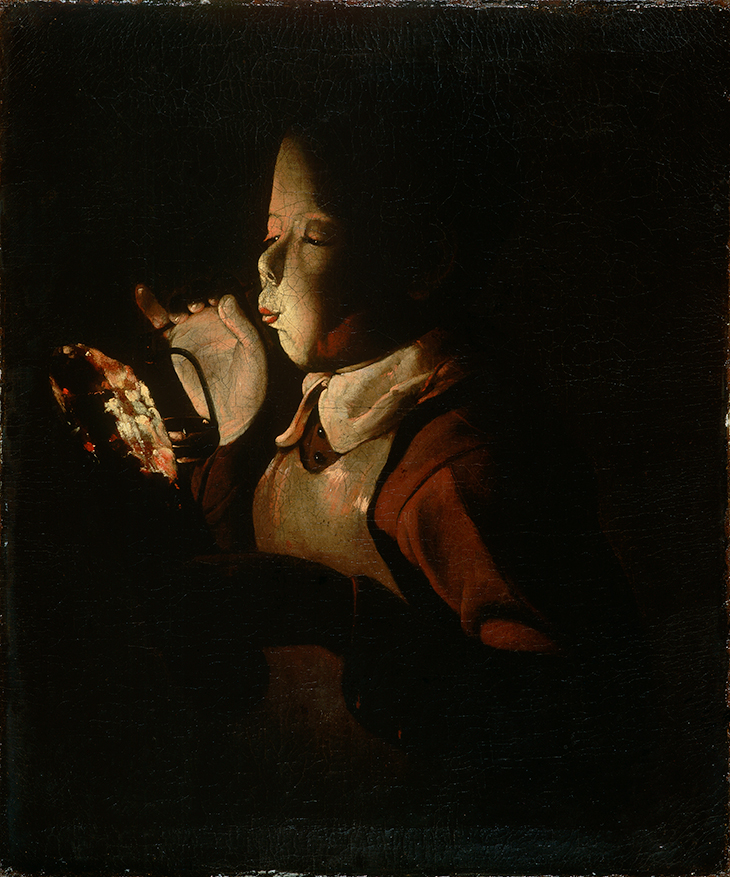
By far the biggest gift was made by the Granville family between 1969 and 1986. Their bequest gave the museum one of its best-known works, Georges de la Tour’s Caravaggesque Boy Blowing on a Lamp (c. 1640), as well as canvases by Courbet, Delacroix and Odilon Redon. But the larger part of their vast collection is focused on the 20th century, from Juan Gris and other cubists to artists of the so-called first and second Écoles de Paris, such as Nicolas de Staël. African masks and Cycladic sculptures collected by the Granvilles are set up in conversation with these canvases, in a museological approach apparent throughout the galleries: while everything is carefully considered, there is a pleasing lack of hierarchy here – the decorative arts, for instance, are given equal weight amid contemporaneous fine art. A highlight of the ‘Louis XIV’ rooms is a gilded marquetry clock attributed to André-Charles Boulle (c. 1728); modelled with allegorical figures of Day and Night after Michelangelo’s sculptures on the Medici tombs in Florence, it was rediscovered in the museum’s stores during this recent overhaul, and has been meticulously restored at the Louvre. Viewers are nudged to see connections. ‘I think “connection” is a good word to describe the museography of this museum,’ Liot agrees, ‘because everything is presented at the same level. We don’t have tiers; so there’s a feeling of freedom. People come here because they want to dream.’
‘Day and Night’ clock (c. 1728), attributed to André-Charles Boulle. Photo: © Musée des Beaux-Arts de Dijon/C2RMF/Michel Bourguet

On some level though, there still lingers a whiff, a bouquet, you might even say, of old hierarchies and strictures. On my way back through the 17th century, I pass Charles de la Fosse’s Bacchus and Ariadne, painted for Louix XIV’s now-lost Château de Marly near Versailles. Let’s hope it’s pinot noir the wine god has been drinking – or Philip the Bold may just turn in his tomb.
From the September 2019 issue of Apollo. Preview the current issue and subscribe here.
